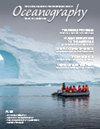Comparison of Two Soundscapes: An Opportunity to Assess the Dominance of Biophony Versus Anthropophony
IF 3.2
4区 地球科学
Q1 OCEANOGRAPHY
引用次数: 2
Abstract
Sound travels further through water than light and is one reason why many marine animals use sound to communicate and gain information about their surroundings. Scientists collect recordings of these underwater sounds to gain information on species’ habitat use, abundance, distribution, density, and behavior. In waters where visibility is severely limited or access is difficult or cost-intensive, passive acoustic monitoring is a particularly important technique for obtaining such biological information over space and time. The “soundscape” of an ecosystem is defined as the characterization of all the acoustic sources present in a certain place (Wilford et al., 2021). A soundscape includes three fundamental sound source types (Figure 1): (1) anthropophony, or sounds associated with human activity; (2) biophony, or sounds produced by animals; and (3) geophony, or sounds generated by physical events such as waves, earthquakes, or rain (Pijanowski et al., 2011). Studying soundscapes can provide biological information for a specific habitat, which could then be linked to ecosystem health status and other bioindicators. This information can be used to monitor the habitat over time, allowing for rapid detection of habitat degradation, such as in response to human-driven events. Comparison of Two Soundscapes: An Opportunity to Assess the Dominance of Biophony Versus Anthropophony两种音景的比较:评估生物声与人类声优势的机会
声音比光在水中传播得更远,这也是许多海洋动物利用声音交流和获取周围环境信息的原因之一。科学家们收集这些水下声音的记录,以获得有关物种栖息地使用、丰度、分布、密度和行为的信息。在能见度严重受限或难以进入或成本高的水域,被动声学监测是在空间和时间上获取此类生物信息的一项特别重要的技术。生态系统的“声景”被定义为某个地方存在的所有声源的特征(Wilford等人,2021)。声景包括三种基本的声源类型(图1):(1)人声,或与人类活动相关的声音;(2) 生物音调或动物发出的声音;和(3)地震声,或由波浪、地震或降雨等物理事件产生的声音(Pijanowski等人,2011)。研究声景可以为特定栖息地提供生物信息,然后将其与生态系统健康状况和其他生物指标联系起来。这些信息可用于随着时间的推移监测栖息地,从而能够快速检测栖息地退化,例如应对人类驱动的事件。两种声景的比较:评估生物声音与人类声音优势的机会
本文章由计算机程序翻译,如有差异,请以英文原文为准。
求助全文
约1分钟内获得全文
求助全文
来源期刊

Oceanography
地学-海洋学
CiteScore
6.10
自引率
3.60%
发文量
39
审稿时长
6-12 weeks
期刊介绍:
First published in July 1988, Oceanography is the official magazine of The Oceanography Society. It contains peer-reviewed articles that chronicle all aspects of ocean science and its applications. In addition, Oceanography solicits and publishes news and information, meeting reports, hands-on laboratory exercises, career profiles, book reviews, and shorter, editor-reviewed articles that address public policy and education and how they are affected by science and technology. We encourage submission of short papers to the Breaking Waves section that describe novel approaches to multidisciplinary problems in ocean science.
 求助内容:
求助内容: 应助结果提醒方式:
应助结果提醒方式:


